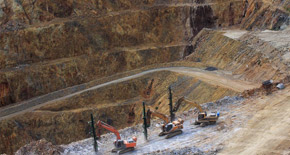Contactless GPR Tomography on Walls Supporting Giotto’s Mural Paintings.
An Experimental Application on the Historic Walls that host Giotto’s Mural Paintings in the Santa Croce Basilica, Florence—Italy

This work is part of a cooperation research jointly developed by the DST (Department of Earth Sciences of the Florence University, Italy), the ODP (Opificio delle Pietre Dure, an Institute of Excellence of the Italian Ministry of Culture) and IDS GeoRadar part of Hexagon, to investigate the potential of applying GPR (Ground Penetrating Radar) to cultural heritage buildings’ masonries.
Cultural heritage buildings represent examples in which the use of invasive techniques for the investigation of structures is not acceptable, as they are contrary to the principles of protection and conservation dictated by Italian regulations. However, acquiring information regarding the internal structure of the walls, their state of conservation, and the presence of cracks and voids, is fundamental for the safety of the structure, where often the walls are the support of decorative elements and priceless wall paintings for our cultural heritage. Furthermore, the determination of the type of masonry and of the mechanical characteristics represent necessary data to define the structural model for a punctual evaluation of the seismic vulnerability.
Among the non-invasive investigation techniques, GPR (Ground Penetrating Radar) generates great interest for its ease of use and speed in the execution of an investigation, for the reliability of results and for the variety applicable fields. GPR technology is traditionally used on structures of various forms and materials, however, only recently and in the context of particular scientific cooperations, it has been applied for the experimental investigation of historical masonry giving positive results.
The objects of this experimental study are the walls of the Bardi Chapel inside the Santa Croce Basilica in Florence, Italy. (See figure below).
The Basilica of Santa Croce in Florence (Italy) was erected in the years 1294-1443, on the site of two previous churches; today, the Basilica represents one of the most notable historical buildings in Florence. The Bardi chapel, owned by the Bardi’s powerful bankers family in Florence, hosts the work of the artist Giotto di Bondone (1267–1337), a cornerstone in the history of painting as he opened the doors of Renaissance painting with a new style intended to change the history of art.
The side walls of the chapel are entirely covered with a painting cycle created with the “dry” technique by Giotto. Today, this cycle of wall paintings is marked in some areas by gaps due to previous conservation interventions.
The chapel has a square plan and consists of a single span with a cross vault with ribs; the side walls without stone decorations hold the paintings by Giotto, while the back wall has a double-arched window. These structural features, combined with the considerable height of the space, make it an excellent example for the extensive application of the GPR technique.
The experimental use of GPR technology solutions applied to cultural heritage has led to the search for ways of displaying data that would facilitate their interpretation and archiving. Therefore, as part of the research on the digitization of diagnostic campaigns using the BIM methodology conducted by the DST, this methodology was also applied to the case study of the Bardi Chapel. In recent years the methodologies to build a 3D HBIM model, in which to embed all the investigations performed in the real space, have been established as a standard modus operandi,.
The BIM methodology is currently used in architecture and engineering because it allows the insertion of the properties and information of a project into a three-dimensional model. Thanks to the financial support of the OPD, and with the permission of the Opera di Santa Croce, which has overseen the conservation of the Basilica since the 14th century, the HBIM content and a full 3D tomographic GPR survey of the walls of the chapel has been developed.
In this study, the fragility of the pictorial surfaces and the necessity for an upcoming and more extensive conservation project induced us to experiment, for the first time, with a new type of contactless GPR antenna.
The purpose of this project was:
1. To apply, for the first time, a new generation of GPR antenna, operating in a contactless mode with respect to the investigated surface.
2. To define the structure and assemblages of the masonry supporting Giotto’s paintings.
3. To define the masonry parameters for a seismic vulnerability assessment, according to Italian regulations.
4. To build a HBIM informative model of the Bardi Chapel, in which to embed all the investigations in their real 3D space.
Materials and Methods: Stream T, the GPR Contactless Antenna
In this work, a new generation of GPR antenna had been used: Stream T by IDS GeoRadar. This new equipment consists of 3 antenna modules connected in a continuous chain (90 cm width) - emitting at 900 MHz, with horizontal polarization, which is suitable to acquire data in a contactless mode - operating at approximately 15 cm distance from the masonry surface and successfully safeguarding the fragile setting of Giotto’s mural painting.
Differently from other GPR systems that provide a 2D profile of back-scattered electromagnetic energy along the survey, the 3-antenna module of Stream T allows to reconstruct, for each survey, the 3D structure of the medium providing a GPR tomography of the medium and avoiding the interpolation of multiple scans.
The collected data was then processed with IDS GeoRadar’s GRED HD Software, providing multiple views of radar data and speeding up the pick out anomalies.
2.2. Surveying
In order to operate all along the walls of the Bardi Chapel, which is 7 m high, Stream-T GPR antenna was mounted on the basket of an elevator crane and kept at a constant distance from the wall’s surfaces while moving in subsequent vertical strips laterally contiguous. Each strip was accurately referenced in order to place the 3D tomography in the right 3D space on the HBIM content. Preliminarily, the wall thickness was measured in the HBIM model (62 cm) and it indicated a very good and solid masonry status; in addition a set of four DAC tests and endoscopies was previously carried out on the external façade to punctually determine the setting of the masonry, such as drill holes for taking a seismic survey.
2.3. HBIM Informative Model
The creation of a 3D model of the chapel would highlight the detected wall structure and show the location of the various surveys and their results in a unified framework. The choice of the BIM methodology allowed to interpret the results in a close relationship with the context in which the surveys were carried out and to link descriptive information to the model objects for the easy identification of all elements (investigation, instrument, date of the test, results, etc.)
In the case of the BIM model of the Bardi Chapel, information relating only to the GPR surveys were entered, pending further diagnostic investigations in the construction phase.
The chapel structures were modelled, orthophotos of the walls applied on the model and objects to view the wall volumes investigated were created while radargrams were inserted inside the walls to reconstruct a 3D tomography for the clear visualization of anomalies in the wall surface.
The final model proved as a valid aid for identifying anomalies in their exact position in relation to the presence of the painted surface, and for storing the data of the diagnostic investigations in a single container complete with all the information: a perfect full 3D tomography of the Bardi Chapel masonries.
3.1. GPR Interpretation
The aim of the survey was to verify the presence of voids and fractures on the Bardi Chapel walls and to define the structure and assemblages of the masonry. The GPR tomography and the radargrams clearly showed some anomalies in the depth range of 0.20–0.30 m from the surface.
The tomography and radargrams acquired on the north and south walls of the Bardi Chapel showed a typical spotty distribution of the anomalies, related to the casual assemblage of the stones/bricks and mortar that constitute the wall filling. The radargrams collected on the north wall of the Bardi Chapel showed some alignments, which characterized the first external levels of the wall and have been associated with the frescoed section.
Conclusions:
This study allowed to successfully introduce 3D GPR tomography into the 3D HBIM content for a detailed analysis of the walls of the Bardi Chapel in the Santa Croce Basilica in Florence, Italy. The new generation of GPR antennas used made it possible to work in contactless mode and to carry out the analysis without compromising the integrity of the mural paintings. The 3D HBIM model appears to be essential for correctly positioning GPR data and creating a database with all the 3D information for optimal conservation strategies and design interventions.
Also, this research conducted on the Bardi Chapel masonry reveals the good technical level of the 14th century master masons involved. In the early 14th century, when the Santa Croce Basilica was built, masonry techniques had achieved a very good level, as testified by the many towers, religious buildings, and civil buildings built in Florence in those times, which are still standing in good conservation conditions.
Original Version of this article published on: Heritage | 3D HBIM Model and Full contactless GPR Tomography: An Experimental Application on the Historic Walls That Support Giotto's Mural paintings, Santa Croce Basilica, Florence - Italy.
Download the Use Case.



































